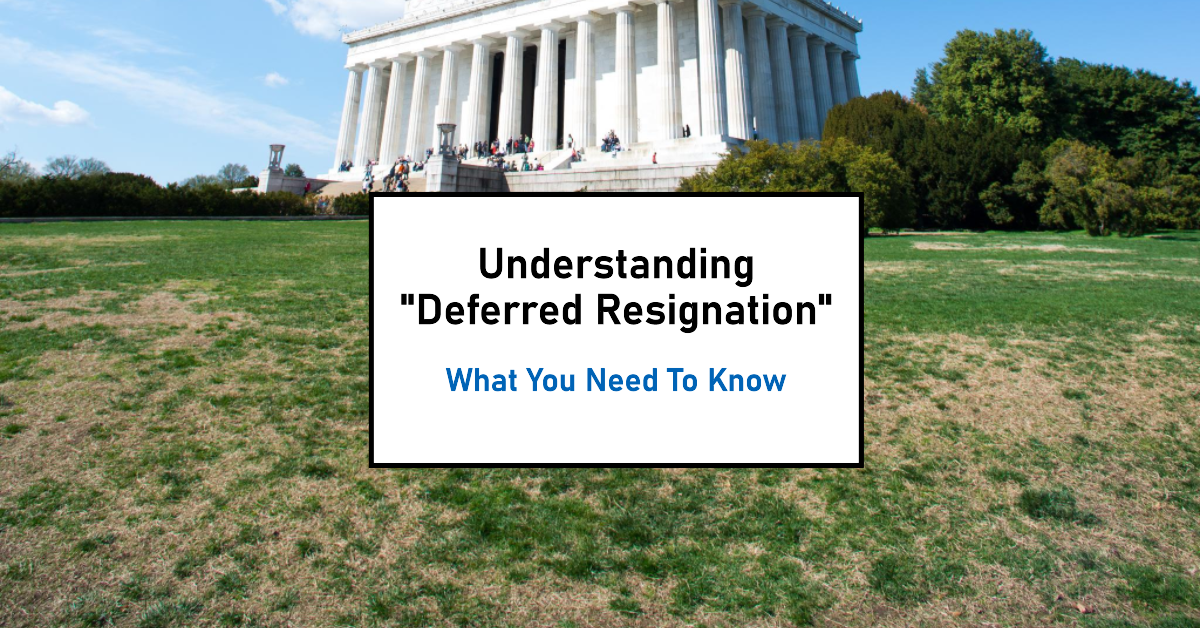Trump’s Deferred Resignation Explained: What You Need to Know
Envision the unsettling surprise of checking your government email one evening and discovering a new policy that could profoundly reshape your career. That’s what happened this past week for thousands of federal employees. The Trump administration’s “Deferred Resignation” program burst onto the scene, drawing mixed reactions and raising questions about how this bold move might affect federal agencies, individual retirement plans, and even the broader economy. Rumors of eight months of paid leave and a quick path out of public service have placed many federal and military workers—particularly those nearing retirement—on high alert.
If you are a federal or military employee (active or retired) over age 55, these developments can be doubly concerning. You might be weighing the potential benefits of a lump-sum departure against the security of your pension and benefits. Because PlanWell has spent over 30 years helping federal workers as a financial advisor for federal employees, we recognize just how complex this situation seems. In the following sections, we’ll break down the essentials of Trump’s Deferred Resignation program, explore its possible financial impact, delve into the policy context, consider the history behind it, and wrap up with practical thoughts on how federal employees can stay informed and prepare for what lies ahead.
Understanding Deferred Resignation
When federal employees first saw the subject line “Resign” in their inboxes, it seemed almost too strange to be real. Yet the Office of Personnel Management (OPM) rapidly confirmed that this was no hoax: it was, in fact, the Trump White House’s new attempt to streamline the federal workforce. The gist is straightforward: eligible workers can “accept” a deferred resignation by February 6, 2025, and remain on the federal payroll until September 30, 2025, with full pay and benefits intact for those months. The intention, as stated in official memos, is to reduce the workforce smoothly—avoiding the potential complications of more traditional buyouts or massive reductions in force (RIFs).
While the memo itself reads like a voluntary resignation document, many observers interpret it as a form of pressure. The administration, for example, made it clear that a “majority” of federal agencies are slated for downsizing. Notably, the government singled out particular groups of employees—such as those in national security and immigration enforcement—for exclusion from the program. So, if you are a mail carrier, a member of the armed forces, or an immigration officer, you are exempt. Everyone else, however, faces a fork in the road: stay at your desk with the possibility of being caught in future RIFs, or accept a departure sweetened by up to eight months of pay.
One of the most frequently asked questions is, “Does it really amount to eight months’ severance?” Strictly speaking, OPM calls it “paid administrative leave.” The employee’s official final day is September 30, 2025, or earlier by personal choice. You can even accelerate your resignation if you land another job before then, but the date cannot be extended beyond the end of September. Whether you must keep working during this time depends on your agency’s preference, but the default assumption is that an employee who opts in will either have limited duties or be placed on administrative leave soon after acceptance.
So who qualifies? The short answer is nearly everyone in the competitive or excepted service who isn’t specifically excluded by the administration. That said, the guidelines remain somewhat flexible. Agencies have the final say in whether certain positions must remain staffed—and confusion persists around which employees fall under the “national security” umbrella. Typically, if you received the official memo in your government inbox and are not in an exempt category, you’re probably eligible.
Before we move on, here is a concise snapshot of the key features of this program:
| Criteria | Details | Notes |
|---|---|---|
| Severance/Leave | Approx. 8 months’ salary | Technically “paid administrative leave” for most employees |
| Eligibility | Majority of civilian federal workforce | Excludes USPS, Armed Forces, immigration & national security roles |
| Key Deadline | Opt-in by Feb. 6, 2025 | Final departure date is Sept. 30, 2025 |
From a purely technical standpoint, the rules appear straightforward. Yet the real-world implications for retirement plans, health benefits, and job security are anything but simple. This is especially true for those with fewer than five years to retirement or for individuals relying on Federal Employees Retirement System (FERS) income. In the next sections, we will tackle the potential economic impact of this mass exodus, how federal employees might be personally affected, and why some are likening this to a watershed moment in federal employment policy.
Economic and Financial Implications
Whenever the federal government introduces a sweeping initiative involving personnel cuts or buyout programs, there are bound to be substantial monetary consequences. This time is no exception. High-level officials have hinted that the administration aims to achieve billions of dollars in federal savings over the coming years—some have mentioned estimates as high as $100 billion. That large figure, however, is speculative. Indeed, many experts caution that these cost-savings projections might not account for the hidden toll of reorganizations, lost expertise, or the cost of hiring contractors to fill crucial gaps.
From the administration’s standpoint, offering eight months of paid administrative leave to a broad swath of employees in exchange for their resignations could be cheaper than implementing a complicated RIF. In a typical RIF scenario, employees often have appeal rights before the Merit Systems Protection Board, especially if they believe they were wrongfully terminated. This can drag out the process for months or even years. By dangling a guaranteed paycheck and a convenient exit, the White House has found a neat workaround to the usual red tape—at least in theory.
But there’s more to the story. Each employee who accepts the deferred resignation is also keeping full benefits until the end of September. That includes health insurance, retirement accrual, and other benefits that can be quite costly to the government on a per-head basis. Underscoring this point, the VA alone said it had placed 60 diversity and inclusion specialists on administrative leave pending their eventual departure, costing the agency roughly $8 million per year. While those employees represent a mere fraction of the entire VA workforce, multiply such figures across multiple agencies, and the costs add up quickly.
To put it in context, compare the White House’s program with private-sector norms:
| Category | Federal Impact | Private Sector Comparison |
|---|---|---|
| Severance/Buyout Length | Approx. 8 months’ salary | 3-6 months for higher-level roles |
| Estimated Govt. Savings | Up to $100 billion (projected) | N/A |
| Legal Complexity | High (RIF rules, union contracts) | Lower but still regulated by state/federal law |
Private corporations rarely offer eight months of severance unless a senior executive is departing, so at first glance, the Deferred Resignation package seems generous. But the primary difference lies in the government’s overarching goal: to drastically reduce the workforce without dealing with lengthy appeals or abrupt pink slips.
For individual federal employees—especially those on the cusp of retirement—the big question is: Is it worth accepting the deferred resignation? After all, many in the federal workforce have a vested interest in eventually receiving a FERS annuity or drawing from the Thrift Savings Plan (TSP). Leaving a few years early could reduce the ultimate retirement benefit. On the other hand, some employees might weigh the possibility that their agency could be drastically reorganized, leaving them vulnerable to a forced departure in less favorable terms.
When deciding, it helps to consider your broader financial picture. Some employees may find that riding out eight months of continued salary—while possibly seeking a new private-sector job—offers an unexpected chance to transition smoothly. Others will worry about losing out on additional creditable service time that would have boosted their eventual pension payouts. There is no one-size-fits-all solution here, which is why we often advise taking a thorough look at your finances, your time in service, your immediate job prospects, and the structure of your retirement benefits.
Finally, we cannot ignore the concern that a mass exodus from government could harm institutional knowledge. If large numbers of midcareer and senior employees accept the offer, agencies could lose decades of specialized expertise overnight. That diminishes the capacity of the federal government to administer programs effectively and could prompt a spike in contractor use—and contractors are often more expensive than their federal counterparts. Hence the heated debates around whether the projected $100 billion in savings are realistic. The real impact, both on the federal budget and on federal workers’ personal finances, remains an open question.
Policy and Political Considerations
To understand how we got here, it’s useful to look at the broader political environment. On paper, the Trump administration’s stated goals are to streamline the civil service, return employees to physical offices, and “restore accountability.” In practice, critics argue that this Deferred Resignation policy is a backdoor method to push out employees whose roles the administration deems unnecessary. Moreover, it’s widely perceived that this is part of a broader wave of changes that also target diversity, equity, and inclusion (DEI) teams, as well as staff members hired or retained under policies from previous administrations.
Within Congress, reactions span the ideological spectrum. Some Republicans see the Deferred Resignation approach as “efficient business,” praising the White House for saving taxpayer money and reducing bureaucracy. Others, particularly Democrats, voice concern that the measure operates outside well-established buyout rules. Voluntary Separation Incentive Payments (VSIPs), for example, are currently capped at $25,000. This new approach circumvents that cap by classifying the payout as “administrative leave” rather than a direct buyout, which could present legal challenges down the road. Senate Democrats have indicated they are contemplating whether states’ attorneys general might file lawsuits to block or revise the program.
Meanwhile, unions like the American Federation of Government Employees (AFGE) have not minced words. Their leadership frames the program as a “purge” designed to create an inhospitable environment for career civil servants, forcing them to choose between near-term security and an uncertain future. Union officials point out that a stable, qualified civil service is vital to delivering public services effectively. They fear that, aside from immediate disruptions, the program could set a precedent for future administrations to disregard the standard civil service protections when attempting to reduce staffing.
Then there is the matter of “Schedule F,” a now-infamous Trump-era executive order that sought to reclassify thousands of federal positions into an at-will category, removing traditional Merit Systems Protection Board safeguards. Although that order was rescinded by the subsequent administration, there have been hints of reviving the concept—especially after this year’s re-installation of certain White House advisors who previously championed it. The interplay between Schedule F–type reclassification and Deferred Resignation remains to be seen, but many experts believe that if large-scale departures occur now, it could pave the way for a restructured civil service that’s far more susceptible to political influence.
Lastly, it’s worth noting that the administration has also begun collecting lists of employees in DEI-related positions, as well as those still under their probationary period. This signals that “targeted” layoffs or reassignments may be next in line. So, from a purely policy-driven standpoint, Trump’s Deferred Resignation program is not an isolated initiative. It’s part of a broader chessboard that includes potential workforce reclassification, agency-level reorganizations, and even the possibility of across-the-board RIFs if the “voluntary” measure does not yield the desired results.
Historical Context and Public Reaction
This is hardly the first time a presidential administration has sought to shake up the federal workforce. Yet the pace and breadth of the current plan harken back to earlier chapters in American history. Ronald Reagan famously tangled with the air traffic controllers in the 1980s, and Bill Clinton once launched the “National Performance Review” to modernize government. Each of these past efforts left a lasting imprint, but typically involved incremental changes over months or years. What we are seeing with the Deferred Resignation program feels more sudden and sweeping.
It also mirrors some of the themes from Trump’s first term. Back in 2020 and 2021, many agencies experienced abrupt shifts in leadership and repeated attempts to curtail telework. We also saw a wave of resignations and reassignments following the January 6, 2021, Capitol attack. Now, in his second time around, President Trump appears determined to finalize changes that eluded him previously, introducing measures like the Return-to-Office mandates and a revitalized push to strip job protections from policy-related roles.
Among the general public, the reactions have been varied. Some see the measure as a heavy-handed approach to force out career feds who might oppose the administration’s direction. Others, fed up with remote work narratives or allegations of inefficiency, applaud the White House for taking bold action. This public perception matters because, ultimately, political support or backlash influences how thoroughly Congress or the courts may intervene.
For federal employees themselves, shock and confusion generally top the list of emotions, especially for those who were blindsided by the late-January email. Many are turning to their unions, their agency’s human resources, or specialized financial advisors for guidance. Indeed, the novelty and uncertainty of the policy—coupled with the speed of its rollout—have led some employees to question its legality and consider legal challenges. But not all employees dislike the program. Some are calling it a golden opportunity to retire earlier or pivot to the private sector, netting nearly a year’s salary without the burden of reporting to an office.
Conclusion
Trump’s Deferred Resignation program may be the biggest development to hit the federal workforce in decades. With an opt-in deadline looming and the potential for a mass reshuffling (or outright exodus) of experienced professionals, federal and military employees of all ages have to weigh their options carefully. Will this program undercut or enhance your personal finances? Could it lead to more significant retirement benefits or hamper them? Are you comfortable navigating uncertain waters if you stay?
At PlanWell, our team holds the Chartered Federal Employee Benefits Consultant (ChFEBC), Certified Financial Planner (CFP), and AIF designations to help you navigate your federal benefits. Given the complexity and the potential long-term impact on pension, TSP balances, and overall career trajectory, making an informed decision is paramount. If you remain hesitant, an excellent next step is to delve deeper into the specifics of your personal finances, speak to a qualified advisor, or engage with colleagues who have already made their choices. Even if you decide not to opt in, it’s wise to have a contingency plan, considering the future may hold further reorganizations, RIFs, or expansions of at-will classifications.
If you’re unsure what this means for your long-term retirement security, we invite you to learn more at one of our free Federal Retirement Planning Workshops or our FERS webinar. We’ll walk you through scenarios and help you evaluate the pros and cons with confidence.Sign up for a Federal Retirement Planning Workshop to see what lies ahead and get a clearer view of your financial future.










